The planned excavation works in the area of the Benedictine monastery in Bakonybél carried out as part of the Kings – Saints – Monasteries research program and launched with the support of the Eötvös Loránd Research Network (ELKH) have been completed. The excavation carried out in the courtyard of the monastery provided a wealth of important information, some of it quite surprising, about the centuries-old history of the monastic community founded by Saint Stephen.
The results show that the vast majority of the ground surface that has been researched was undeveloped during the Árpád era, so it can be assumed that the core of the church and the medieval monastery lay outside of this area. On this basis, it can be concluded that the church and central buildings are probably to be found under the Baroque buildings that are still standing today. With the field work completed, the research has entered the processing phase, during which the evaluation of the results is supported by various natural scientific methods.
While this might initially seem hard to believe, it is nevertheless true: even though Bakonybél is one of the earliest monasteries of the Kingdom of Hungary, the former buildings and relics of the Benedictines had never previously been examined by any field research that was specifically guided by scientific considerations. Within the framework of the research program supported by ELKH, in 2022, for the first time, a path was opened for a planned archaeological excavation that did not necessarily have to be adapted to the needs of any construction projects.
 Georeferenced 3D photogrammetric summary floor plan of the sections of the archaeological excavation
Georeferenced 3D photogrammetric summary floor plan of the sections of the archaeological excavation
Saint Ladislaus and his contemporaries
The features observed in the current southern courtyard of the monastery reveal the changes in the use of the area from the Árpád era to the early modern and contemporary periods. Although no finds from the time of the founding king of the Hungarian state came to light during the research, the recovered legacy of the medieval monks was enriched with finds dating back to the earliest times. More interesting from the point of view of the Benedictine past than the prehistoric vessel fragments, Roman coin and small late Avar strap end found this year is the fragment of a silver coin featuring the circular inscription "[+LADIS]LAVSRE[X]", which testifies to the functioning of the renowned abbey, with its significant landholdings, during the time of Hungary's canonized king Ladislaus.
 A fragment of a coin minted by (Saint) King Ladislaus I.
A fragment of a coin minted by (Saint) King Ladislaus I.
However, this coin was not the only memory of the monastery's existence during the 11th century to be found. Uncovered in the westernmost section of the excavation site were four different partially or completely intact burials, as well as a large number of disturbed bones, skulls and piles of bones that, in total, gave indication to at least twice that many people having also been buried here. Among the dead were a child, a man who had suffered serious injuries during his lifetime, and an individual whose grave pit had been lined with stones placed in a row. Based on the researchers' observations, these burials that began in the 11th century ‒ or possibly in the first half of the 12th century ‒ show a clear direction: the newer graves were dug to the south of the previous ones, meaning that the area used for burials gradually expanded towards the south.
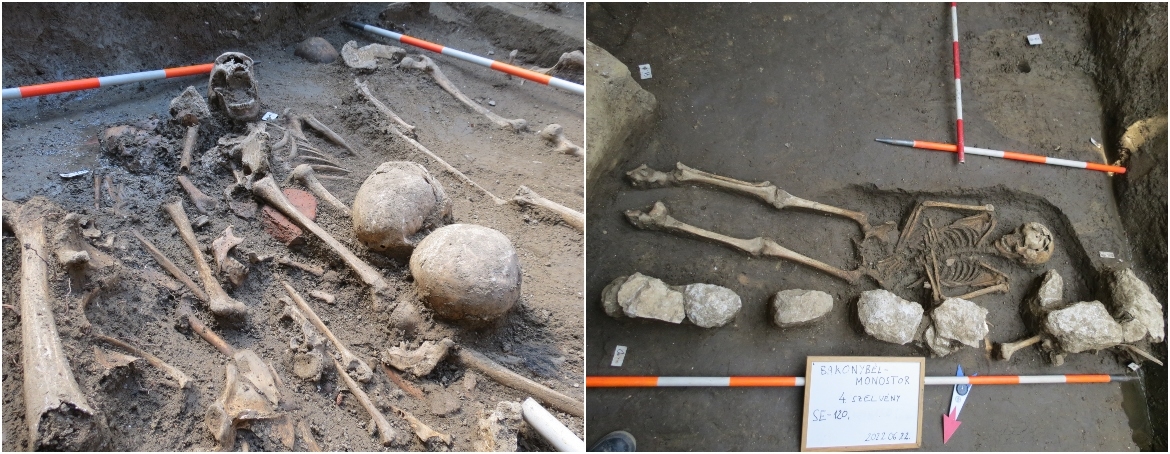 Bones of disturbed skeletons above an in situ burial; stone-lined Árpád-era tomb
Bones of disturbed skeletons above an in situ burial; stone-lined Árpád-era tomb
Szerzetesek temetője vagy laikusok sírjai?
The interpretation of the cemetery section raises some compelling questions. An obvious explanation would be that it formed a whole together with the 33-grave section of the cemetery previously excavated about 40 meters to the west-northwest. In 2010, Pál Rainer led a preliminary excavation in connection with a construction project, during which he identified the graves found at that time as being parts of the servants' cemetery surrounding the church. At the same time, in the newly excavated section, the graves were only excavated in the area of a roughly 2.5-meter-wide strip running from north to south, as if the graves were not part of an ‘outside’ cemetery after all, but were instead located in a relatively narrow, cloister-like covered space. With this being the case, instead of being a resting place for lay people, this area may have been used to bury the Benedictine monks. As a cautionary note regarding the conclusions, however, the researchers have so far only excavated the graves in a three-meter-long section, so it is questionable whether their arrangement along a single band can be generalized.
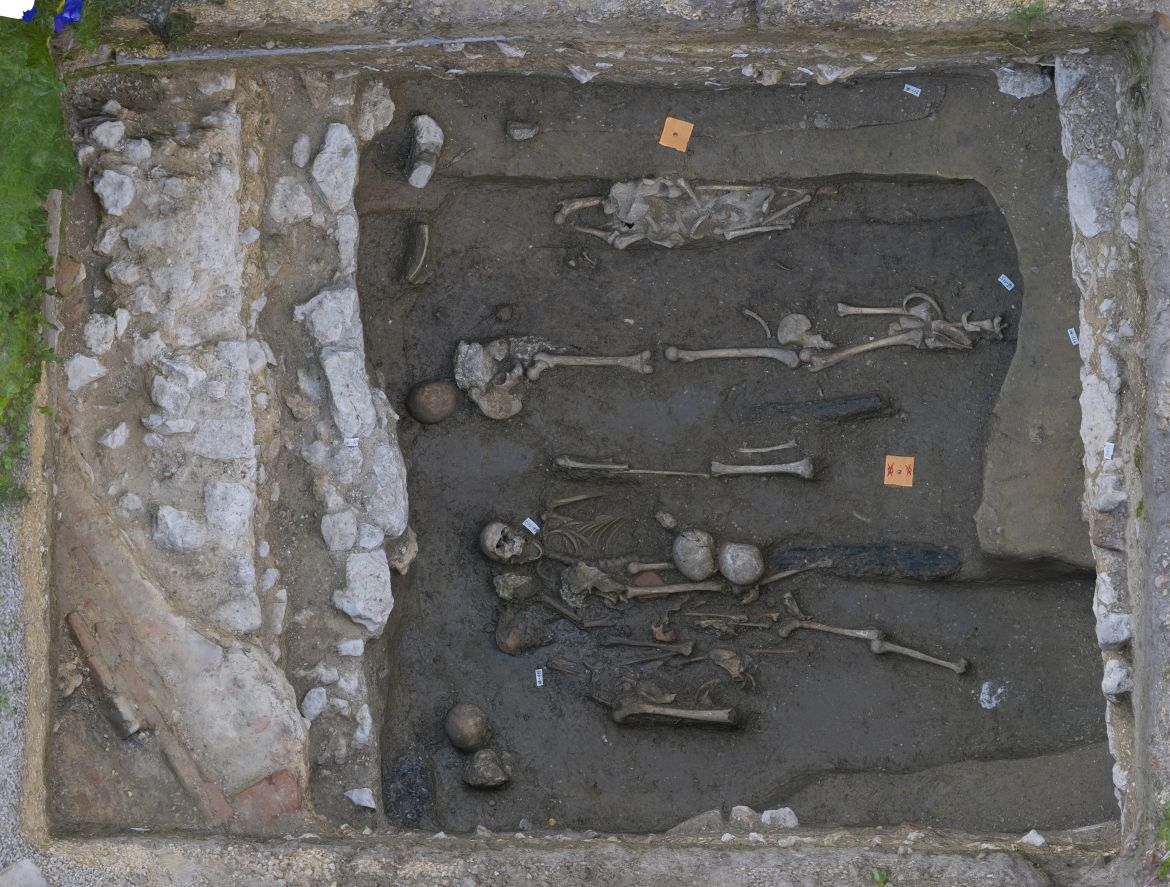 3D photogrammetric image of the upper grave layer of the cemetery section
3D photogrammetric image of the upper grave layer of the cemetery section
Construction work and fire damage in the late-medieval monastery
The earliest structure with remaining physical traces in the excavated area can be indicated by a row of stones, which, based on its regular design, could perhaps be the stone foundation of a wooden-framed building. Later, after that structure was demolished, a new late medieval building with stone walls joined with mortar was erected. On the floor level of this structure, which had been renewed several times, a characteristic rubble of red carbonaceous wattle-and-daub rubble has collapsed. The debris points to the likelihood that a wooden structure plastered with clay and held together with iron nails burned down. After the devastation caused by the fire, the burnt ruins were smoothed, and perhaps this damage also contributed to the fact that, later on but still also during the 14th or 15th century, they decided to demolish the building. Erected in its place was a new, probably larger two-storied building with the same north-south axis. Based on the excavated wall fragments, this new building was more than 8 meters long and more than 4.5 meters wide.
 The walls of the late medieval buildings built over the graves and the burnt floor level of one of them
The walls of the late medieval buildings built over the graves and the burnt floor level of one of them
Cleanliness inside – a garbage heap outside
Found about 8 meters east of the eastern outer wall of the large building was a remnant of a foundation wall with the same north-south axis as the others. The masonry is most likely a remnant of the approximately only 0.7-meter-wide outer wall closing off the monastery complex to the east. It is striking that the archaeological layers that can be observed on the eastern side of the wall are quite different from those on the western, inner side. The abundance of finds here unlike those unearthed elsewhere makes it clear that, in contrast to the carefully kept interior spaces of the monastery, here, beyond the outer wall, there must have been an external, unbuilt space. Next to the wall, a layer extremely rich in charcoal, ceramic, and animal bone fragments indicates part of a garbage heap mainly used for disposal of kitchen waste.
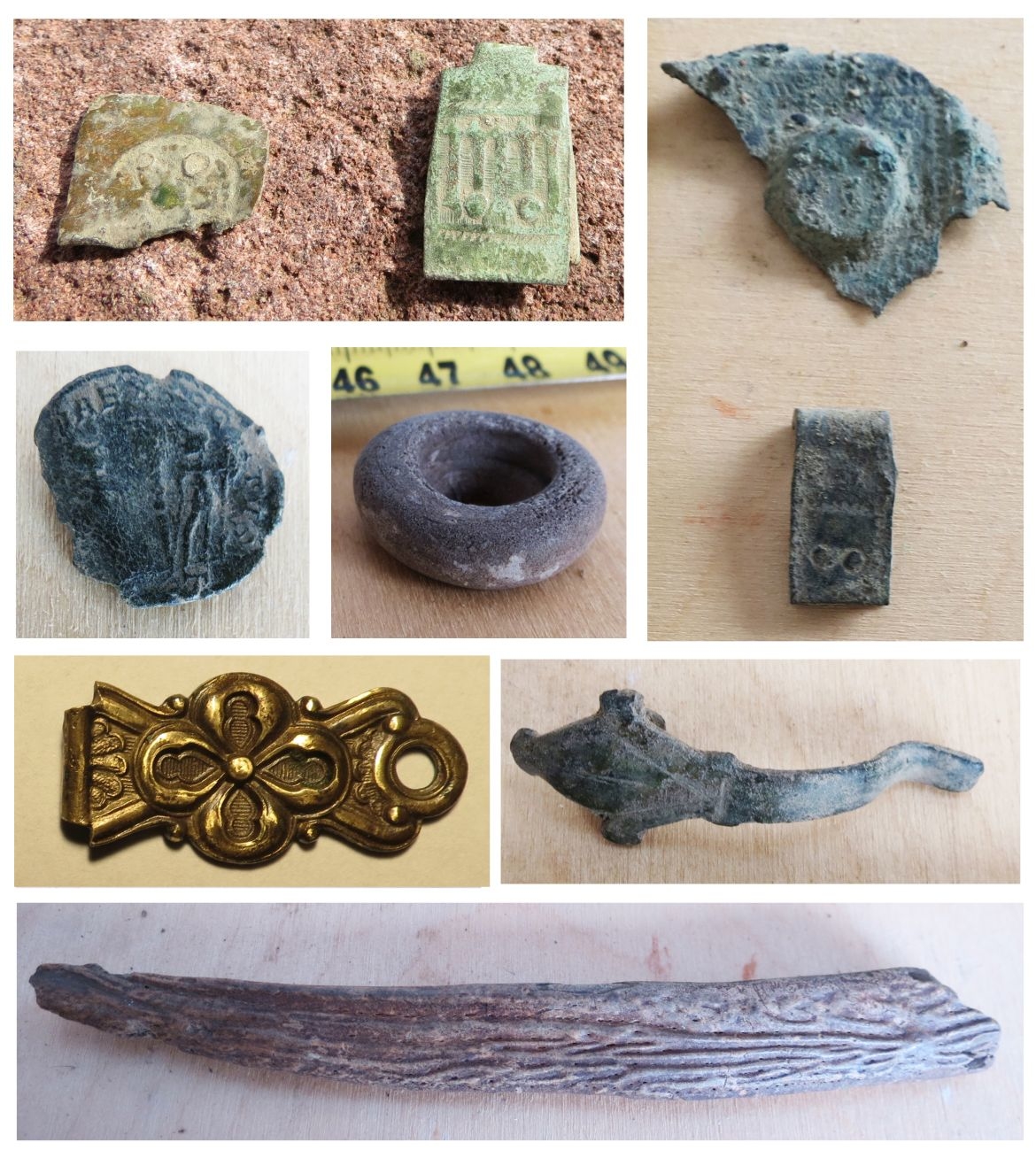 A selection of small finds (book mountings and clasps, a Roman medal, the mouth of a glass bottle, the antler handle of an iron tool)
A selection of small finds (book mountings and clasps, a Roman medal, the mouth of a glass bottle, the antler handle of an iron tool)
To the outside of the outer wall, that is, to the eastern side, was added a building with an extremely deep foundation, approximately 4.5 meters wide in terms of its internal dimensions. The location of this structure outside the outer wall and in the immediate vicinity of the garbage heap indicates a space used for agricultural or other functional purposes. It was not uncommon for food waste to be discarded close to the place of origin, so it is conceivable that this space might have served as a kitchen. If this is the case, then the imposing base walls could perhaps be explained by the need to support the weight of a chimney used to dissipate smoke generated by baking and cooking..
Dark times: the shift from a monastery to a fortress, with a castellan instead of an abbot
One of the important results of the current excavations was the discovery of a narrow but deep trench found lying parallel to the excavated wall parts of this building and which was dug into the refuse scattered at the end of the Middle Ages. Vertical piles with a diameter of 20-25 cm were placed in the trench running on the outside of the stone walls at a distance of 10-20 cm from each other, with the gaps between them then filled with clay, earth and stones of various sizes. The pilings were filled with numerous painted and shaped brick fragments, as well as plastered masonry stones with painted decorations, perhaps with a cuboid pattern. The painted bricks and stones clearly indicate that the once ornate buildings of the abbey may have suffered serious damage when the piles were dug. The piles placed in the trench were formed into a palisade wall, which could in turn support an earth embankment that strengthened the outer wall of the monastery from the outside. With this rapidly-built fortification, the stone walls of the monastery could be made much more resistant to artillery, which was playing an increasingly important role in warfare.
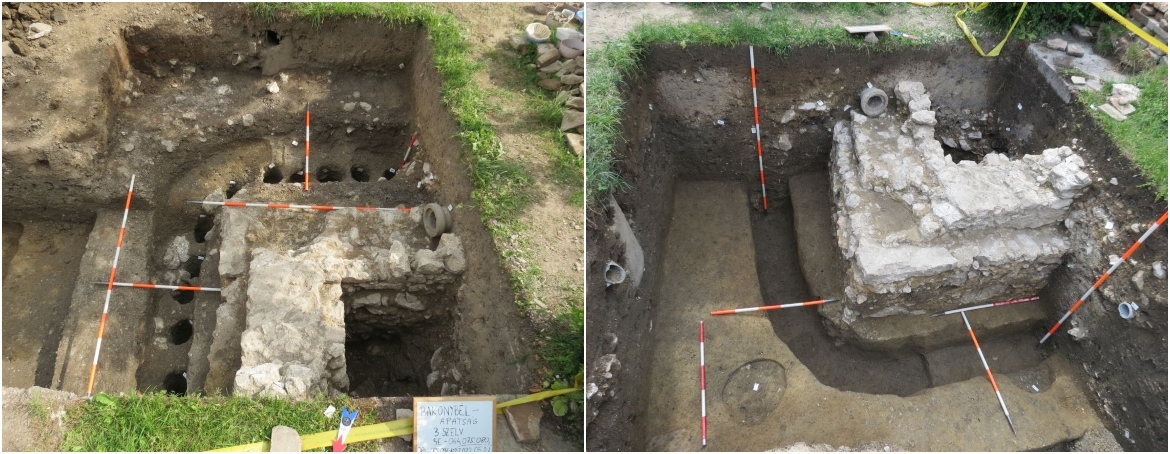 Full excavation of the reinforcement of the stone building with a wood-and-earth structure with the positions of the piles and the ditch dug for the piles
Full excavation of the reinforcement of the stone building with a wood-and-earth structure with the positions of the piles and the ditch dug for the piles
The drastic change that took place in the history of the monastery at the beginning of the 16th century is clearly visible from the archaeological observations. Based on the information contained in the relevant documents, Pál Bakics, a military captain serving under Ferdinand I, ransacked the abbey in 1534 and imprisoned the abbot, forcing the monks to move to Pápa. The building complex was converted into a fortress, which was then placed under the command of a castellan. During the civil war raging between Ferdinand and János Szapolyai and their followers – that is, well before the Turkish conquest – the outer stone walls of the monastery were reinforced, and some of the consecrated buildings were used as stables.
A fresh start not without difficulties after the expulsion of the Turks
After the civil wars at the beginning of the 16th century, the monastery soon became abandoned, and only after the expulsion of the Turks did life resume here again. While the researchers' modern-day observations can be reconciled at several points with the picture emerging from historical sources, also coming to light is the memory of a previously unknown, unfinished structure. Found almost exactly in line with the medieval outer wall was a strikingly wide, roughly 1.3-meter mixed stone and brick wall, the foundation of which was constructed with repeated irregular gaps and protrusions. These irregularities in the construction in and of themselves indicate the unfulfilled intention of further building, and this is confirmed by a simply backfilled foundation trench that continues for at least three meters to the south. Due to its dimensions and the depth of the foundation, the wall remnant would have belonged to some important, unfinished building, such as a church, a one-story wing of the monastery, or even a tower.
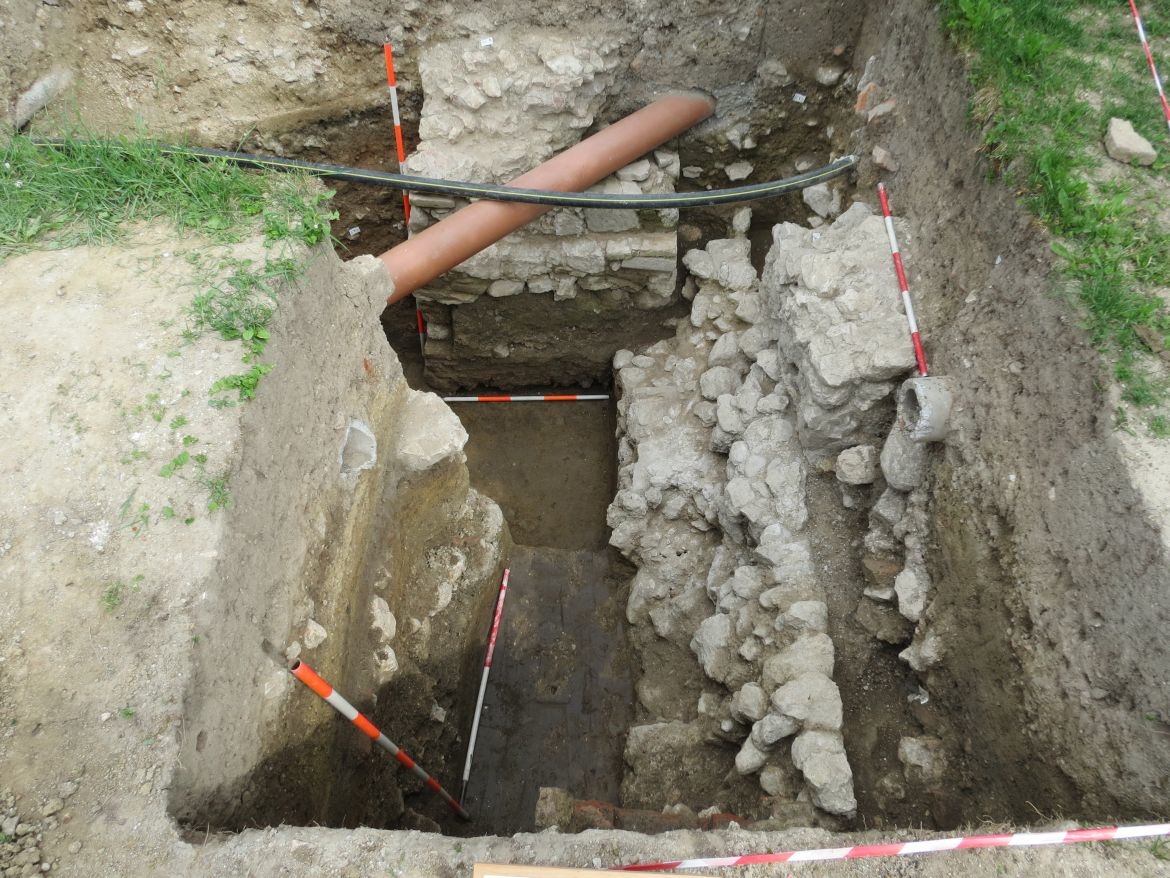 The wide, irregular masonry from the early modern period cutting into the medieval wall
The wide, irregular masonry from the early modern period cutting into the medieval wall
Summary: So where did the Árpád era monastery stand?
In addition to the many other interesting results of the excavation, the researchers also gained important, largely indirect information about the entire building complex of the medieval monastery. Based on their observations, the vast majority of the surface currently being researched ‒ the eastern four-fifths ‒ remained unbuilt during the Árpád era. Thus it can be assumed that not only the church, but also the core of the medieval monastery, were located outside of this area. Comparing all of this with Pál Rainer's excavation results from 2010, it can be concluded that the church and the central buildings are probably to be found underneath the Baroque buildings still standing today.
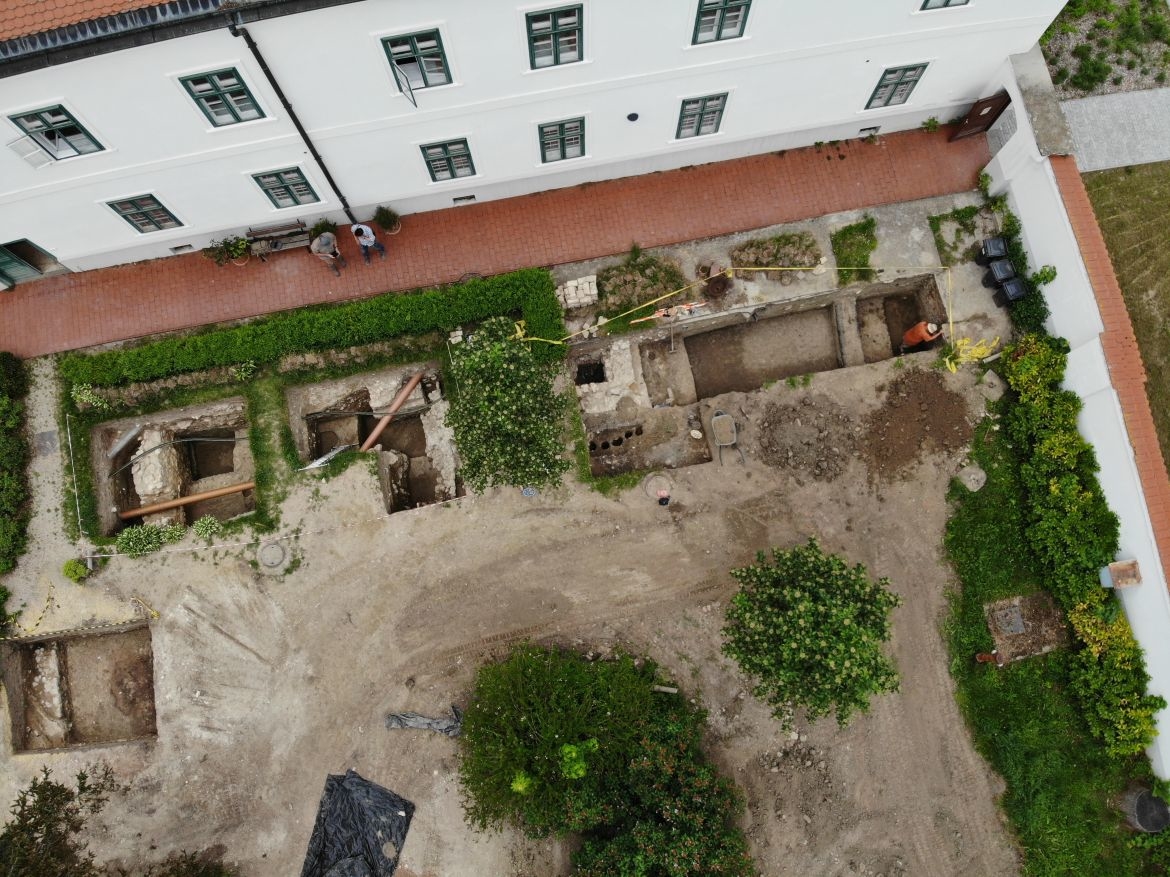 Drone image of excavation sections on the south side of the present-day monastery building
Drone image of excavation sections on the south side of the present-day monastery building
With the completion of the field work, the research entered a new, processing phase, during which the evaluation of the results is being supported by various natural scientific methods, including the physical anthropological examination of human skeletal remains, carbon isotope tests for precise dating, micromorphological analysis of soil samples, and a new ground-penetrating radar survey of the site.
Original article at elkh.org

